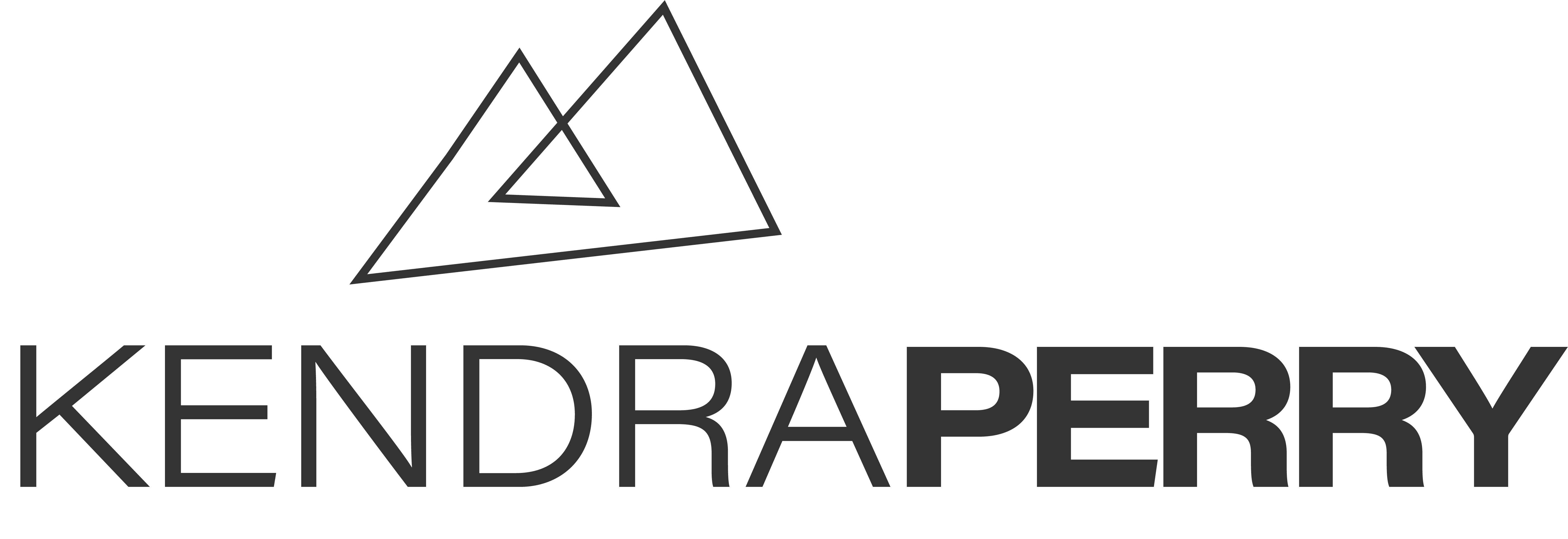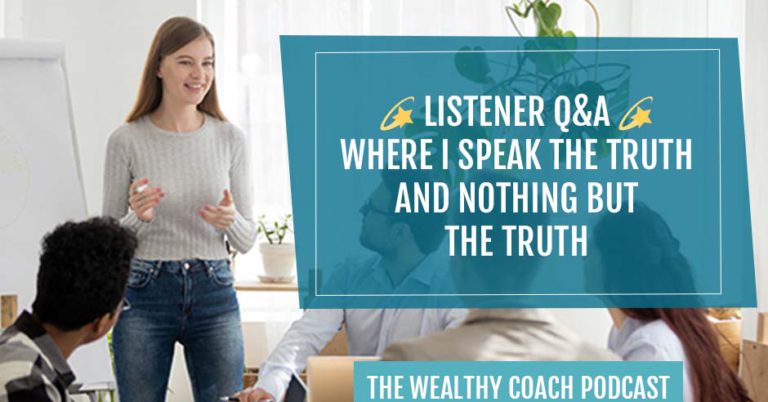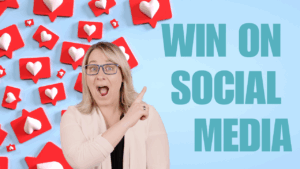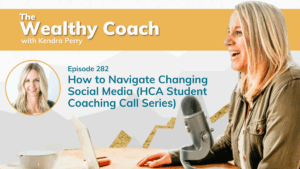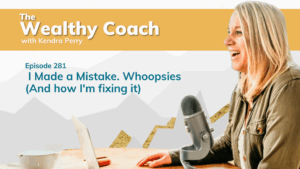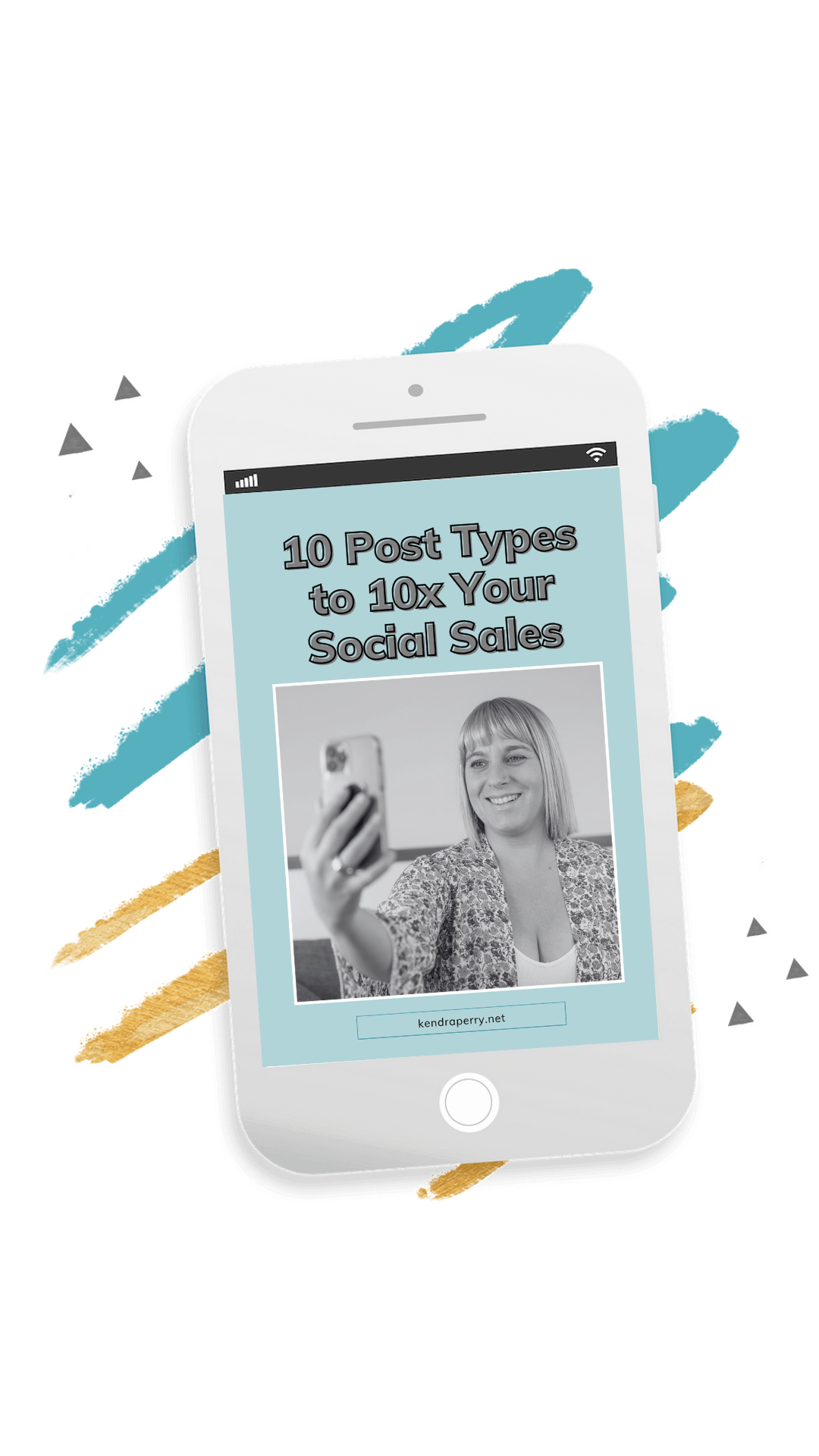For today’s episode, Kendra Perry holds a Listener Q&A portion where she speaks the truth and nothing but the truth! From building an audience, naming your brand, to discovering what your clients truly need, this episode is full of hard questions and honest answers on becoming a successful business owner. Buckle up and join this informative ride!
—
Listen to the podcast here
💫 Listener Q&A 💫 where I Speak The Truth And Nothing But The Truth
What Is The Best Length For A Qebinar?
In this episode, we are doing a Q&A. I want to thank everyone who submitted awesome questions over Instagram. I appreciate your questions and also being able to serve you on the show. Let’s not waste any time. Let’s dive into the questions. The first question is from Sierra. She’s asking, “What is the best length for a webinar? Mine is almost two hours, and I’m thinking it’s too long. Thoughts?”
Sierra, I would completely agree with you. Almost two hours is pretty long for a webinar. A lot of people are probably not going to stick with that until the end. The goal of the webinar is to get people to the pitch. There’s not necessarily an ideal time because it’s going to be a little bit different for everyone. When it comes to running webinars, the testing process is incredibly important.
It depends. I don’t know if you were running a live webinar or an evergreen webinar because I find the length will be a little bit different. When I do live webinars, I typically don’t get to the pitch until about an hour. When it’s live and there are people on and people are commenting, there’s a bit more energy with it. I find people will stay on a little bit longer.
When I’m doing an evergreen webinar or an automated webinar, something that’s pre-recorded where I’m not on live, I usually try to shoot for a shorter amount of time. My goal is always to get to the pitch at about the 40-minute mark. It also depends on whether your webinar is going to cold traffic versus warm traffic. If you are running ads for an automated webinar, these people don’t know you. They don’t trust you. You’re just some talking head on the internet. It’s probably better to have a shorter webinar because they’re not going to necessarily be willing to stay until the end because they don’t trust you yet.
However, if you’re doing a webinar with your audience or your warm audience, the people who are following you on Instagram and they’re on your email list. They already know, like, and trust you. You can probably get away with doing a bit of a longer webinar because they like you. They want to stick around until the end. If this is an automated webinar or a pre-recorded webinar, I would probably aim to get to the pitch for about 40 minutes or something like that. If it’s a live webinar, I would wait and try to get to the pitch for an hour.
I don’t count that at the length of the webinar because if people are sticking around, then whatever. You want to be able to get to the pitch and then the people who are interested will stick around, and the people who aren’t will go offline or will get off the webinar. Almost two hours is pretty long. You’re probably talking way too much. You’re probably teaching too much. One tip here that I can give you is webinars are not about teaching. They’re about shifting people’s perspectives and getting them ready to buy your program.
This is a big mistake that I made with my webinar for a very long time. This is a big mistake that coaches make with their content as well. They focus too much on teaching and not getting people ready to buy. I’m guessing with this webinar, you’re trying to teach a lot and you’re trying to say too much. What I would recommend is to get your webinar shorter.
There are three main points. You don’t want to be doing any teaching. You want to be shifting beliefs that are preventing them from getting the results. Let’s say you’re in a weight loss niche. One of the main things people believe about weight loss is they need to restrict their favorite foods. Maybe that’s the reason why they haven’t succeeded because they can’t go on these super restrictive diets and stop eating all the foods they love. That’s a big reason why they haven’t lost weight in the past or maybe why they failed in a different program.
I’m totally obsessed with Glucose Goddess. This is where I get this example from @GlucoseGoddess on Instagram. If you’re not following her, go follow her. I have my continuous glucose monitor on my arm right now and I’m obsessively tracking data. Her whole thing is you don’t necessarily need to change what you eat. You just need to choose foods and eat foods in a particular order so as to flatten your glucose curve.
We don’t want to have those big spikes of glucose and bring in the insulin, and then you get fat storage and all of these things. Her whole thing is you can still eat all your favorite foods, you just need to eat them in a little bit of a different way to have more of a rolling hill for a glucose spike versus a big spiky mountain. Maybe your point number one is why you can still lose weight even while eating your favorite foods every single day, or how to lose weight without giving up your favorite foods and restricting yourself into oblivion, or something along those lines.
Hopefully, what you can see is basically I’m shifting a perspective. I’m doing a paradigm shift versus teaching them something. What will serve you is to choose three points and shift three things or shift three paradigms because that’s what is going to sell on a webinar. It’s these paradigm shifts. When you help people look at something differently, that will get them excited about what you are ultimately selling. That’s my best tip for shortening my webinar, but I do agree with you. Two hours is probably way too long.
You do want to test it. This is why it’s good to have analytics. If you’re doing an automated webinar, you can host the video on something like Vimeo or you can use something like StealthSeminar, which is what I use, and you get a lot of analytics. You can see where people are dropping off. Earlier in 2022, I was noticing that everyone was dropping off before they got to the pitch and my pitch was over an hour. I realized that my webinar was way too long.
I got to the pitch at 40 minutes by tightening up the webinar and getting rid of some content. Now actually almost everyone will make it to the pitch and stay for the pitch, which is very exciting. If you’re doing a live webinar, you can get those analytics from Zoom and you can figure out where people are dropping off. It will help you come up with the optimal webinar time for your audience.
How Do I Get More People To Show Up To My Webinar?
The next question is from Jenny, and this is also about webinars. She says, “I did a webinar last week. I had 102 sign-ups, which was so exciting, but only fifteen showed up live. How do I get more people to show up for my webinar?” What I will tell you is I’ll give you a benchmark. Benchmarks are not Bibles. It’s not the end-all-be-all. We want to be comparing our own data with our own data. What you’re aiming for is at least 25% of people to show up for a live webinar.
Just so you know, I’ve had as high as 55% of people show up for a live webinar over time, with testing and figuring out what will make people show up. I did an episode on this. It was five different ways to get people to show up live. What I will say is with 15 and 102 sign-ups, you’re lower than that benchmark. You’re not too far off. With 102, you’d probably want to get at least 26 people to sign up. Obviously, 30% and above is going to be better.
I won’t go too into it too deeply because you can go listen to that entire webinar, but you want to make sure you have a strong reminder series. You want to make sure you’re sending out reminders through emails. I do a 24-hour reminder. I do a day of reminders, a one hour and a ten-minute. I do quite a bit few reminders. I also do text reminders. This is a bit more of an advanced strategy, but this has made a huge difference in my life.
If you’re using something like ClickFunnels, I use FG funnels. There is a way for you to set up text reminders so that people get notified. I think this is valuable. Another way you can get people to show live is by offering them something of value if they stay until the end. I usually give away some juicy free resources if people stay until the end of the webinar. That’s a good way to get people to show up as well.

I do email and text reminders. I also do an add-to-calendar button. I used Add.Eventable.com. That is a button where people can add the event to their calendars. Personally for me, if it’s not on my calendar, it doesn’t happen. I need to put everything on my calendar. That can help people sign-up as well. Also, offering something of value or something good that they would want. That will entice them to show up. You’re almost there. Don’t get discouraged. Add in some of these techniques and listen to that episode that I did on increasing your live show-up rate for webinars and let me know how it goes.
Next is Ginny. Ginny says, “I’m changing my niche and I’m wondering how I should introduce it on Instagram. I’m afraid people won’t follow me, and I’m not sure how to go about it” Ginny, I don’t want you to overthink this. Just move forward. You could start posting content tomorrow for the new niche. If you’re worried about it, do a simple post. You can do it on your stories. You could do it on a post and tell people, “I’m switching gears from this to that. Thank you to everyone who’s followed me for the old niche. I appreciate it.”
Give them permission to unfollow, “If this doesn’t resonate with you anymore, I totally understand. No hard feelings. Go ahead and unfollow me, but if this resonates with you, definitely stick around.” People are going to unfollow you and that’s not a bad thing. You do not want people following you who aren’t interested in what you do. That is going to hurt your engagement. It’s way better to have a smaller following that is engaged versus a bigger following that is unengaged.
I switched from health coaching to business coaching officially in 2019. I regret not starting a new Instagram account. I had about 5,000 followers who were following me for health and wellness. I wished I started a new account because that did hurt my account to have so many people who probably weren’t engaging with my content anymore. If you’re relatively new and you only have a few hundred followers, I would keep the account that you already have. If you’re switching niches within the health and wellness realm, then I would keep the same account.
Health coaching to business coaching is a big shift. People who follow me for health and wellness are probably not business owners. In that case, I wish I had started a new account, but I’m guessing you’re only changing from one wellness niche to another. If you’re concerned about it, do a quick intro and move on but start posting. Take action. Don’t get stuck on this. Most people aren’t even going to notice.
What Is Better: One-On-One Coaching Or A Group Coaching Program?
Lisa’s question, “I’m super new and I’m wondering if it’s better for health coaches to start with one-on-one coaching or do a group coaching program.” There are a couple of different things that you need to understand about yourself and your business for me to answer this question. When people are asking me, “Should I do one-on-one or should I do group coaching?” The first question I ask people is, “How quickly do you need to make money?”
If money is urgency and you’re like, “I need to leave my corporate job. I need to make money fast,” then I would always recommend starting with one-on-one coaching. Why do I say this? I say this because it’s the faster way to get clients. You don’t need any infrastructure. You literally need nothing. Inside HCA, I teach my students how to build a program with a curriculum, whether they are running it one-on-one or as a group.
A curriculum is important, but if you need to make money fast, then you can offer coaching. You don’t need to have anything. The only thing you need is a calendar platform or something like Calendly so people can book an appointment. You also need a way to take payment, which could be something like a Stripe link, PayPal, or whatever.
The thing is if you need to make money fast, it’s always going to be easier to do that with one-on-one coaching. You don’t need to sell to as many people. You could literally reach out to family and friends. You could host a workshop in your local community and you could get clients right away. The thing with group coaching is you need a bit more infrastructure. You need to do things like sales calls. You need to have a curriculum. You need to have a hosting for the group program.
You’re going to need to have a sales page. You’re going to need to have Zoom and understand how to do that. There’s a lot more that you need to set up. You also need a bigger audience size. In a group coaching program, maybe you’re going to want to have 5, 10, or more people in it. That’s more people to sell to. It takes a little bit more time to sign up. If money is a big concern, I always start with one-on-one coaching.
Even if your intention is to have a group program or an online course, that’s fine. At least when you take one-on-one clients, you can be making money as you build your group coaching program. I think you should always get paid to do things because that’s going to take more time. It can take a couple of months to set up a group coaching program. It can take 6 months to even 12 months or more to optimize it, get it profitable, and make that full-time income. While you do that, you might as well be taking on one-on-one clients.
The great thing about the Health Coach Accelerator is that the program that we teach you how to build is one that can be executed as a one-on-one or group. It can even be repurposed into an online course. It’s one program that you can use over and over in multiple ways. There are some people who are averse to doing one-on-one coaching, and that’s fine. If you hate doing it and you don’t want to do it or it’s making you so miserable, then that’s probably not going to serve your clients. You can go straight to the group.
You are just going to need to have a way to pay your bills while you build it because you’re not going to be making money as you build it and optimize it. That’s going to take a little bit of time. Maybe that’s fine for you. Maybe you have a part-time job. If you don’t want to do one-on-one, maybe get a part-time job. Something to pay the bills while you build your group coaching program. Maybe you have some money saved up or whatever. That’s great. Just know that it’s going to take more time to be making money from it and that’s fine if you’re cool with that.
There’s not necessarily something that’s better but what I find is typically people will have more success with a group coaching program if they’ve started with one-on-one. Even if your intention isn’t to do one-on-one, one-on-one doubles as this amazing market research exercise. When you work in real-time with people, you get a lot of feedback and information. You figure out where people are stuck and you figure out what people need to learn. There’s a lot of trial and error that happens that starts to serve you in a group coaching program.
I believe the perfect progression is to start with one-on-one and use that information to build your group coaching program. Use the feedback from a group coaching program to optimize your curriculum so that you can repurpose it into an online course where people don’t need as much access to you, but you’ve already tested it. You figured out where the sticking points are, where people get stuck, and you’ve made it so good that you can offer the curriculum as a do-it-yourself thing with minimal access, and people will still get results. I hope that helps, Lisa.
Is The Name Of Your Business Important?
The next question is from Khalema, “Is the name of your business important?” I don’t think the name of your business is important. This is a way that people get tripped up and procrastinate starting their business. I tell my HCA students to name their businesses their name. That being said, I was speaking with a student a couple of weeks ago and she got tripped up on this. She had this name for her business and she was so attached to it.
When I told her to name her business her name, she used that as a reason to not move forward. She got tripped on that and it paralyzed her. I had to tell her, “You are the boss. You make the decisions. If you don’t want to name your business your name and you want to name it this other name, then go for it.” In the end, I’m always going to encourage you to take action. I’m always going to tell you the best practices. I’m always going to try to make it simple for you, but if what I say doesn’t align, you’re the boss.
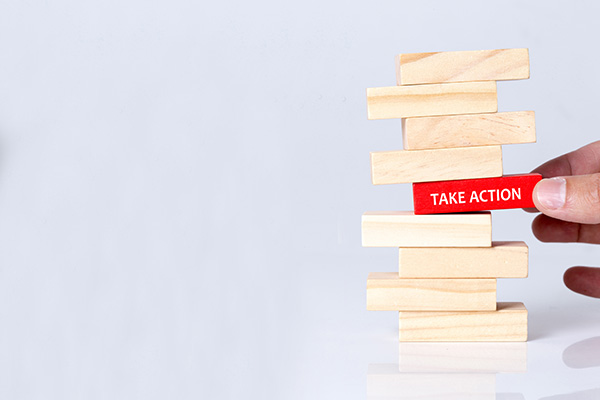
The name of your business isn’t important. Because we’re building a personal brand and we want to be associated with our business, I believe name the business your own name and stress out more about what you’re naming your program. Your program name is way more important than the business name. To keep things simple, you can name your business with your first and last name, and then focus on what you are going to name your program. If you have a business name that you are committed to having, don’t let that hold you back. Do it and move forward.
How To Get Your First Clients?
The next question is from Jean. Jean asked, “How did you get your first clients? Was it through social media?” It wasn’t through social media. I started my business running live workshops in the town that I live in. I wanted to have an online business, but I also knew that would probably be a fast way to get new clients and it absolutely is. There’s something about the energy of in-person. It’s different. We can all agree that it’s very different to be in person with real-life people versus on a Zoom call.
There’s this filter that happens online that dilutes the trust a little bit. The great thing about selling in person is you don’t need to be a great salesperson. When people sense your energy, there’s faster trust that’s built and it’s way easier to get clients. I ran live workshops and I knew it wasn’t a forever strategy because I live in a town of about 10,000 people. I knew it would dry up over time. In the beginning, in the first year of my business, I would host a workshop anywhere that would take me.
With the first workshop that I ran, I got two clients. It was awesome. I was so excited. I think that’s a great way to get clients. This is something I give my students in HCA. I give them a workshop script and a way to pitch different businesses because it’s great. When you host a live workshop for another business, you get access to their clientele. I was hosting workshops. The first one I did was at a natural foods grocery store. I believe I had about 25 women show up. It was very exciting.
I did one at a CrossFit gym. I did a few at yoga studios. I did one at the library. I did one at a hair salon. I literally would do it anywhere that would take me. If they took me, I would do it. That’s how I got all my first clients. It was a long time ago guys, but I think my actual very first client was my friend’s mom and a few friends. I worked with a few friends. I worked with my friend’s mom. The first clients I got that weren’t friends or family were through that workshop. I did that as I was building my online presence. I did eventually start getting clients through social media, but the first clients were friends and family, and through those live in-person workshops.
How Do You Realize What People Want?
The next question is from Sarah. Sarah has a great question. She says, “How do you realize what people want? How do you make content on what people want?” If you want to know something about the people who are following you or the people out there online, the best thing to do is to ask them. If you wonder why my content speaks to you or why it’s so on point, it’s not because I have some magical crystal ball. It’s not because I can read your mind. It’s because I talk to health and wellness practitioners all day every day. I’m talking to them in my paid programs and on social media. I do market research interviews every single year.
The first step to making content that people want is choosing a niche. That is deciding to choose a particular person to work with who has a particular problem. For example, the person could be a new mom, a single mom, or a divorced man. It could be busy professionals, athletes, runners, or outdoor enthusiasts. It’s basically a group of people that have an identity in common, and you want to solve a problem for them. Something like thyroid problems, weight loss, interstitial cystitis, or maybe pelvic floor problems, some sort of big problem that is keeping people up at night and is preventing them from having the quality of life that they want.
Once you choose a niche, it’s about talking with those people. I did market research interviews and you can do the same. You can find those people, sit down with them, ask them questions, and figure out what they’re struggling with. This is a crucial exercise that I put my HCA students through at the beginning of our program. I have them sit down with 5 to 10 of their ideal clients or the people they want to work with. I have them answer a very particular set of questions, “Where are you struggling with the most? What do you feel is holding you back? What have you tried before? What do you feel about your problem? What do you want? What would you want your life to look like?” It’s questions like these to get to understand people.
My content comes from market research. It comes from talking with people and understanding their struggles, their desires, and what their day-to-day looks like. That’s what it’s about. We can’t assume we know what people want and need. We can’t assume their experience or their struggle. We have to speak with them. That’s the only way to know what people want.
Why Do Clients Ghost Me?
The final question is from Eliza. Eliza says, “My last two clients have ghosted me. I’m devastated. Why do people who seem so committed when they sign up do this?” I did a whole on this, episode 95. Eliza, please check out that episode. I’m going to also give you some of the information right here and now because this is a Q&A. The first part about getting clients not to ghost you is qualification. You’re saying these people seem committed when they sign up. Maybe you’re doing a good job of qualifying people. What I will say is despite your best efforts to qualify people, there are still going to be people who fall off the wagon, ghost you, or don’t complete the protocol.

Qualification is really important and this is why I don’t believe that as health and wellness practitioners, we should be working with just anyone because health and healing is a journey. It’s not like you do something for three months and then you’re good. It’s about changing habits and lifestyles. It is a lifelong pursuit. I’m always going to be working on my health for the rest of my life. Even though I feel good, health is important to me.
You want to make sure you are working with people who are willing to do the work. This comes down to your sales call. Sales, in my opinion, is just about qualification. We want to spend the majority of our sales calls, or you might call this a discovery call, listening and learning. The big mistake that coaches make on sales calls is they focus too much on proving. They try to prove how smart they are and they do all the talking. That’s not what the call is about. The call is about helping, seeing if the person is ready to transform, and seeing if they are ready to do the work.
We want to make sure that we are listening for 75% of the call and learning, “Is this someone we can help? Do they seem committed to doing the work?” That is the first step. It is getting the right people in the program. I believe that’s about having a healthy sales conversation with them and making sure that they seem ready to change. The next thing that you want to think about is expectations. I think this is why it’s important to have clear expectations laid out at the beginning of the program. What should your client expect from you as a practitioner and what do you expect of them?
It’s important to go over expectations and tell people what you expect of them as a client. When people ghost you, it’s maybe because the expectations were not aligned. Maybe the person thought they were going to get something, and then they don’t get it. That can be a reason why they ghost you. Let them know what you expected of them. Is there a weekly assessment that you expect them to fill out? Do you expect them to show up to all their appointments? Let them know what should they expect of you. How long are they going to have to wait to get a response from you? What type of advice are you going to offer them? What can they expect from you on the coaching calls?
This is why a client contract is so important because a contract is the meeting of the minds. You’re saying, “This is what I expect of you,” and they’re saying whether they agree or not. Make sure those are laid out so people know how to behave when they’re in your program, and they know what they’re getting and what they’re not getting.

The third thing that you want to think about is front-loading the protocol. Where I went to school, how we did things was we ran a bunch of labs on the client, and then we had a session where we went over the labs, and we delivered the entire protocol to them in that session. What I noticed is that when I did things this way, my clients were so overwhelmed. Some of them would ghost me after that session.
Essentially what we were doing is we were saying, “Look at all the things that are wrong with you, and you have to change your entire lifestyle. Everything you’re doing is wrong and this is what you need to do instead.” I found that didn’t serve my clients. I found that was a huge reason why people ghosted me. It was because of overwhelm. It was too much. We want to give them all the information, but our goal is to get them to commit to the protocol. We want to deliver it to them in a way that is digestible.
What I started doing was instead of giving them everything upfront, I dripped out the protocol, or I released it slowly. What I did was I created a curriculum within my program because the truth was there were a bunch of baseline things that everyone needed. Everyone needed to be eating the whole foods diet, people needed self-care, or they needed mindset. I created a curriculum and I dripped that content out to them over time, and I split their protocol up into stages.
I would explain to them in that session, “These are the different protocols that we’re going to do, but we’re going to do them in this order.” I found by allowing them to do it slowly helped them stick around because they were less overwhelmed. It’s like, “The first thing we’re going to start with is optimizing your diet. This is the diet I want you to eat, and here are the action steps that you’re going to take.” We would then move into the next phase. At some point, we would start to add in supplements or whatever. I find that’s important because when you deliver the entire protocol right off the bat, a lot of people can’t stomach it. They feel like they failed before they even start it.
Eliza, the final thing that you want to think about is a lack of recognition of self-sabotage. It’s very easy somewhere around the middle of the program for people to start to fall off the wagon or feel frustrated because we know with health it can take time to get results. That’s typically a time when people start to self-sabotage or they start to fall back into their old habits.
Understanding human psychology is an important part of helping people change their habits. A great way that you can prevent this from happening is by letting people know that it’s probably going to happen. When this happens, people don’t know what’s happening and they think there’s something wrong with them. They feel crazy. They fall off the wagon and they ghost you.
Whereas if you let them know and you were fully transparent about what the journey looked like at the beginning of your program and you were like, “Usually at this point in the program, you’re going to start to feel uncomfortable. You might start to self-sabotage or you might find yourself falling off the wagon. That is totally normal. When that happens, just know that you’re normal. Everyone goes through this and let’s talk about it.” You can build things into your program to help them get through that.
That awareness piece is key because instead of them not knowing what’s going on, they can be like, “Eliza told me about this. She told me it was going to happen, and now it is. She also told me that she has these tools. I’m going to go look at these tools. I’m going to reach out to her and I’m going to get support for this.”
I hope that was helpful, Eliza. I hope this Q&A was helpful to everyone. I enjoyed doing this. If you have any additional questions, make sure to reach out to me on Instagram @KendraPerryInc. If you have follow-up questions or if anything wasn’t clear, I love connecting with you in direct message on Instagram. I would love to hear from you there.
If you love this episode, make sure to leave me a five-star review on iTunes, or at the very least, make sure you’re subscribed to the podcast and download the last three episodes. It helps me get in front of more people, and it’s a simple and free way that you can support the show. That’s all I got for you in this episode. I will see you on the next episode, same time and place, where I help you become wealthy AF.
Important Links
- @GlucoseGoddess – Instagram
- Vimeo
- StealthSeminar
- Zoom
- ClickFunnels
- FG funnels
- Add.Eventable.com
- Calendly
- @KendraPerryInc – Instagram
- iTunes – The Wealthy Coach
- episode 95
- episode 147
